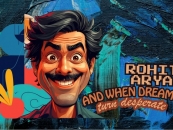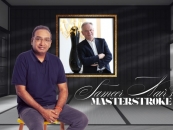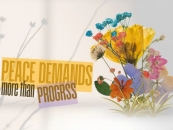-853X543.jpg)
POLITICS: HOW FAR WILL THEY GO WITH HATE?
by HUMRA QURAISHI March 23 2024, 12:00 am Estimated Reading Time: 5 mins, 17 secsHumra Quraishi condemns the targeted communal attacks on Muslims taking place repeatedly, and also introduces Sahar Zaman’s well-researched volume on her grand uncle Talat Mahmood, titled ‘Talat Mahmood – The Definite Biography’.
So, the communal assaults here in the country are getting fiercer by the day, so much so that even students from foreign countries are being targeted now. Quite obviously, one is talking about the manner in which several Muslim students residing in the international hostel of the Gujarat University were attacked by Hindutva goons. The reason: that they were offering namaaz in their hostel rooms! Of course, the wider dimension is the dangerous uncontrolled rise of communal elements, roaming around freely to spread hate and poison people’s lives, their minds.
Correct me if I’m wrong, if these victims of the communal assault were not students from Afghanistan, Tajikistan, Sri Lanka and African countries, would there have been any response from the government. And, what can be termed as shocking is the statement issued by the Gujarat University Vice Chancellor, Neerja Gupta, where she has the audacity to propose the need to sensitise and mentor foreign students about local cultures and practices. While mentioning the 'cultural' differences, she said that Gujaratis were mainly vegetarian and foreign students consume non-vegetarian food, also throw leftovers on the streets, which can attract dogs.
She went further to say that foreign students should be 'mentored' to understand the local culture so that they remain safe! What’s going on! How much more bizarre will her explanations get to have to cover up for the ugly happenings taking place every single day. Students come all the way from foreign countries seeking knowledge, and by the way, they pay for it! Does she not know that?
No media, no person has the courage to ask for these Hindutva armies to be banned, despite several reported instances of special training being given to men, women, even children, to attack others and use arms. This particular outfit, which assaulted the foreign students, is alleged to have direct involvement in rioting and violence. There is a deliberate effort being made to worsen the situation, a sinister design seems to be in place, to put fear in people from the Muslim community.
Another news that shocked this week was the report: “Protests have arisen after a cultural procession organized by the Department of Geography at the Bodoland University in Kokrajhar, Assam, had depicted Muslims as criminals in their rally.”
The incident took place on 16 March, where a cultural event intended as a celebration of Bodo Legendary Heroes during the university’s 23rd varsity week and Thulunga Festival was being held, showed a stage act where two people were dressed in Muslim attire, with beards and skull caps, and also had their hands bound. They are being walked in the rally behind a man reportedly dressed up as a policeman. The two dressed up people are shown to be beaten up by police personnel in the video of the rally.
19.jpg)
Although several students unions - The All BTR Minority Students Union (ABMSU), All Assam Minority Students Union (AAMSU), and North East Minority Students Union (NEMSU) protested and submitted a memorandum urging a thorough investigation into this incident, advocating for disciplinary actions against those involved, the local activists are sceptical.
I’m reproducing here from a report published by Sabrang India, in which the vice-president of Citizens Rights Preservation Committee (CRPC), and former Professor, Taijuddin Ahmed has said that it was a rehearsal and warned the people to be cautious. “It is a motivated conspiracy and a rehearsal…when this vulnerable minority community was attacked and riots took place in 1993, 1994, 2008, 2012 and 2014, prior to them the same rehearsals happened…it was portrayed in the cultural rally that the Muslims are a criminal community - it’s highly condemnable and should not happen in such an institution. It’s not possible without the cooperation of University administration to conduct such offensive acts in the university premises. I want the rise of communal atmosphere in the university premises to go down and instead, the university should focus on the educational curriculum with freedom of thought and expression.”
Meanwhile, on another note, the New Delhi based media personality, Sahar Zaman has brought out a detailed and well-researched volume on her grand uncle Talat Mahmood, titled Talat Mahmood – The Definite Biography. It’s brimming with every aspect of the life and times of the legendary singer.
I quote here from the book: Inching closer to his centenary year in 2024, my wish was to have this exclusive work of non-fiction in the hands of music lovers across the world, to enjoy and marvel at his pioneering journey. This is my gift in lieu of all the love and pride. It’s the story of an artist whose career cuts across the history of India. From being a pre-independence celebrity to being Independent India’s film star. Coming from an educated and cultured Muslim family that supported our freedom movement, this is a musical journey in which the birth and evolution of India is closely entwined. The biography explores his indelible mark on the Golden Era of films by taking you behind the scenes of moments from the recording studio, personal friendships with colleagues and the impact of his stardom…
She also writes: I feel blessed to be his grand-niece where members of my family have dug into their archives of old letters, diaries and incidents to revisit his young days and help recreate exclusive insights. My brother Samar, an aficionado of old film songs, has been the constant ‘fact-checker’ of dates, names and events in his life. This is an attempt to discover Talat as a person and rediscover his music. But it does not claim to be a music analysis of his work. That task is best left to the people who are well-versed in the rich heritage of India’s classical and folk traditions.
It is a volume written with not just an abundance of facts, but with a lot of intense involvement, passion and emotions.





-173X130.jpg)

-173X130.jpg)
-173X130.jpg)


